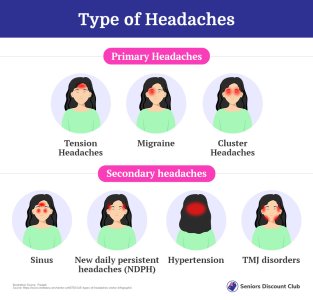Discover What Your Headache Location Can Reveal About Your Health
By
Seia Ibanez
- Replies 6
We've all had more than our fair share of headaches, many of which have been brought by the stress in our lives. We've also had to suffer through some of those dreaded screen-straining headaches while working on our computers, laptops, and phones, too.
But did you know that the location of your headache holds the key to what's triggering it in the first place? London-based General Practitioner (GP) Dr Ann Nainan explains to us what the location of your headache actually means and the best way to treat it.
Headaches and migraines have various triggers, from stress and lack of sleep to overlooked things like poor nutrition, regular intake of caffeine, alcohol, and painkillers. Signs point to something awry in one of those areas if you have a headache.
But it’s also worth noting that the location of the pain in your head might reveal which ONE trigger is to blame.
Sharp pain around your eyes, headaches and strain across your forehead could be caused by spending too much time in front of screens or reading in poor lighting, says Dr Nainan.
Staring is only going to make the pain worse, so be sure to take breaks and look away from the screen from time to time. It might also help to dim the light in the room or to apply a cool compress to the forehead. You may also find relief with tried and true remedies with mild painkillers like paracetamol or ibuprofen, and a cold compress.
Tension headaches brought on by stress and anxiety can also target the forehead, so take a step back and note if you’ve been under a lot of emotional stress in the last few hours or days.
Other triggers include an unhealthy diet with too much sugar and junk food, regular intake of alcohol and caffeine, lack of regular exercise, and being overweight.
It’s also worth noting that hormone levels can contribute to headaches, particularly for women. Keep an eye on your calendar!
You may experience soreness at your temples for multiple reasons, according to Dr Nainan. This could be down to toothache, tension headache as previously discussed, and migraines.
But the pain felt here could also be down to a cluster headache. Dr Nainan explains that these are usually one-sided and can be treated with rest, a cold compress, and some paracetamol.
But if the headache is accompanied by other symptoms like fever and changes to your vision, then you should seek medical attention.
Tension headaches and neck strain can be the cause of pain at the back of the head. But this area of your head is also susceptible to more serious conditions like a brain tumour.
However, most headaches are benign and nothing to worry about. If a headache lasts more than six hours or gets steadily worse, seek medical advice.
Pain that moves across or comes from the area below your eyes is likely down to sinusitis. This condition is usually worse during the colder and wetter months.
Nasal congestion, eye pain, temperature, and forehead pressure can all be symptoms of this infection on top of the headache. To treat it, you may need antibiotics as prescribed by your doctor.
If you only feel pain on one side of your head, you could be dealing with a migraine. Other symptoms of this include sensitivity to light and sound, nausea, a lot of yawning, and strange food cravings.
But if the migraine is accompanied by vision issues, feeling detached from reality, or intense pain that triggers in minutes, then seek emergency medical help.

It’s also worth noting that a headache should start to wear off within six hours and if it doesn't ease with pain relief or is getting worse, especially with other symptoms, you should seek medical advice.
We hope that this helped everyone when it comes to figuring out what your headaches mean!
As always members, please note that we’re not medical professionals and this shouldn’t be considered advice. Be safe, and talk to your GP if you have any concerns.
But did you know that the location of your headache holds the key to what's triggering it in the first place? London-based General Practitioner (GP) Dr Ann Nainan explains to us what the location of your headache actually means and the best way to treat it.
Headaches and migraines have various triggers, from stress and lack of sleep to overlooked things like poor nutrition, regular intake of caffeine, alcohol, and painkillers. Signs point to something awry in one of those areas if you have a headache.
But it’s also worth noting that the location of the pain in your head might reveal which ONE trigger is to blame.
Sharp pain around your eyes, headaches and strain across your forehead could be caused by spending too much time in front of screens or reading in poor lighting, says Dr Nainan.
Staring is only going to make the pain worse, so be sure to take breaks and look away from the screen from time to time. It might also help to dim the light in the room or to apply a cool compress to the forehead. You may also find relief with tried and true remedies with mild painkillers like paracetamol or ibuprofen, and a cold compress.
Tension headaches brought on by stress and anxiety can also target the forehead, so take a step back and note if you’ve been under a lot of emotional stress in the last few hours or days.
Other triggers include an unhealthy diet with too much sugar and junk food, regular intake of alcohol and caffeine, lack of regular exercise, and being overweight.
It’s also worth noting that hormone levels can contribute to headaches, particularly for women. Keep an eye on your calendar!
You may experience soreness at your temples for multiple reasons, according to Dr Nainan. This could be down to toothache, tension headache as previously discussed, and migraines.
But the pain felt here could also be down to a cluster headache. Dr Nainan explains that these are usually one-sided and can be treated with rest, a cold compress, and some paracetamol.
But if the headache is accompanied by other symptoms like fever and changes to your vision, then you should seek medical attention.
Tension headaches and neck strain can be the cause of pain at the back of the head. But this area of your head is also susceptible to more serious conditions like a brain tumour.
However, most headaches are benign and nothing to worry about. If a headache lasts more than six hours or gets steadily worse, seek medical advice.
Pain that moves across or comes from the area below your eyes is likely down to sinusitis. This condition is usually worse during the colder and wetter months.
Nasal congestion, eye pain, temperature, and forehead pressure can all be symptoms of this infection on top of the headache. To treat it, you may need antibiotics as prescribed by your doctor.
If you only feel pain on one side of your head, you could be dealing with a migraine. Other symptoms of this include sensitivity to light and sound, nausea, a lot of yawning, and strange food cravings.
But if the migraine is accompanied by vision issues, feeling detached from reality, or intense pain that triggers in minutes, then seek emergency medical help.
Key Takeaways
- The location of a headache can indicate its cause and suitable treatment according to London-based GP Dr Ann Nainan.
- Eye strain from prolonged screen time can result in headaches focused on the forehead. Breaks, cold compresses, and appropriate lighting can help alleviate this pain.
- Different forms of headaches like tension, migraines, and cluster headaches can all manifest with pain focused in the temples.
- More severe headaches located at the back of the head, one side of the head, or behind the eyes could be indicators of more serious conditions and should be checked by a medical professional.
It’s also worth noting that a headache should start to wear off within six hours and if it doesn't ease with pain relief or is getting worse, especially with other symptoms, you should seek medical advice.
We hope that this helped everyone when it comes to figuring out what your headaches mean!
As always members, please note that we’re not medical professionals and this shouldn’t be considered advice. Be safe, and talk to your GP if you have any concerns.
Attachments
Last edited:










